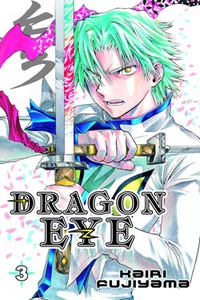Review
by Theron Martin,Dragon Eye
GN 2-3
| Synopsis: |  |
||
Several decades ago the D Virus spread across the world, turning everything it infected into a rampaging monster called a Dracule and thus drastically reducing the human population. Those that have emerged to combat the monsters are called VIUS and organized into combat squads. Squad Zero Captain Issa may be the most lackadaisical of the captains but is also the strongest, and additionally possesses a special item called a Dragon Eye which can briefly increase his power further still. While seeking his missing sister Caira, he leads a squad that includes the newbie sword specialist Leila and twin-bladed Sosei, a man who carries a grudge against Issa. After wrapping up one battle against a Dracule somehow smuggled into Mikuni City, Issa leads an ad hoc team to investigate reports of especially large Dracules sighted on the outskirts of the city, only to discover a far greater problem than he or his superiors bargained for. |
|||
| Review: | |||
Who needs to worry about trivial things like character or plot development or originality when more than 90% of your content is action, and the rest is either being silly or setting up more action? Actually that's not entirely fair. Manga-ka Kairi Fujiyama does make at least a minimal effort to establish characters during the second and third volumes of this post-apocalyptic shonen action series, as Sosei does explain why he has it out for Issa and how he's going to get his revenge while still working alongside Issa. We also learn that Issa is a bit of a fruitcake when not on active duty and that Issa is both far older than he looks and has a background with the bad guys, but little else. Newly-introduced characters get just enough of a personality outline to define them as separate entities but no more than that, and aside from the aforementioned, even established characters get little more definition. To make sure you have little time to notice such flaws, Fujiyama piles on a whole bunch of new characters, but so far it is hard to care about any of them except maybe Issa. Even Leila, the obligatory cute girl who actually is not entirely useless in a fight, does not have enough going for her at this point to have much appeal. At least Fujiyama realizes where the strength and focus of the series lies and consistently plays up to it: action, action, and even more action for good measure. This being a formulaic shonen action series, naturally there has to be some catastrophe that redefines the world and makes it suitable for an action format (in this case the D virus), some way to create monsters to fight (the D virus turns everything it infects into Dracules), and some weirdly-named organization established to fight said monsters (VIUS), in which the hero is, of course, hardly an ideal team player. Naturally the catastrophe promotes an upsurge in mystical or spiritual powers (because, of course, catastrophes always redefine the laws of nature), and naturally each warrior-type character sports either complicated special moves, specialized weaponry, or both. Of course the hero has the strongest moves and the greatest special powers, and what fun would it be to make attacks without everyone explaining what fancy move they're doing? Of course, the shonen action format being what it is, this title will sell simply on the strength of all the action and fancy moves it offers. The fact that it lacks even a shred of originality, and has nothing more compelling in it than Issa wondering what has happened to his missing sister, may be entirely irrelevant. It offers “cool” battles, and lots of them, so who cares if everything here has been done several times before and usually better? Although his style lacks imagination, Fujiyama does demonstrate respectable skill in his crispy-drawn renderings of both humans and Dracules, which readily portray personalities with just basic expressions. The shading used in Leila's eyes makes her look weird rather than implying distinctive eye color, but the grinning, toothy, weasel-like Dracule designs, which give the impression of evil cuteness, make up for that, while background art strikes just the right balance of simplicity and detail necessary to frame and back the action content. Occasionally the poses of characters in the height of fights scenes can be found wanting, but it does not happen commonly enough to detract from their fluid pacing and organization. The quality of the color artistry on the front and back covers cries out for a few pages to be done in color, too, but alas, that is not to be found in Del Rey's production of the title. Each volume opens with an artistic note from Fujiyama, Del Rey's standard blurb on honorifics, and two pages of background info and key character blurbs. At the end of each volume are 2-4 pages of four-panel strips, which provide humorous takes on key scenes, followed by three pages of translation notes and an untranslated preview of the next volume. Del Rey retains all of the original sound effects while providing small, unobtrusive translations. If you are relatively new to the field of manga then Dragon Eye might work for you, since you have not had enough experience to be prejudiced against it for its unoriginality. The only others who might appreciate this one are dedicated fans of shonen action content and those who deeply appreciate common, if well-drawn, shonen artistic styles. |
| Grade: | |||
|
Overall : C
Story : D+
Art : B+
+ Good artistry despite generic design, lots and lots of action. |
|||
| discuss this in the forum (1 post) | | |||
| Production Info: | ||
|
Full encyclopedia details about Release information about |
||